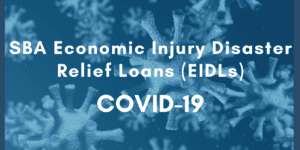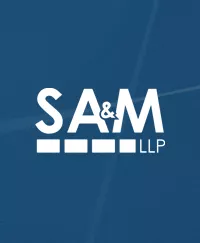
COVID-19 EIDLs - General Overview
You can find the SBA requirements for COVID-19 related EIDLs at https://disasterloan.sba.gov/ela/Information/EIDLLoans.
To apply for an EIDL, please visit: https://disasterloan.sba.gov/ela/Account/Login?ReturnUrl=%2Fela%2FLoanApplication%2FStartApplication.
- EIDLs are only available to:
- any of the following types of businesses:
- for-profit businesses;
- small agricultural cooperatives; or
- most private, non-profit organizations;
- that are located in a declared disaster area (see the SBA press release in “Recent Updates” below);
- that have suffered substantial economic injury;
- are unable to obtain credit elsewhere; and
- are defined as “small” by SBA size regulations (see “SBA size regulations for ‘small business’” below).
- any of the following types of businesses:
What constitutes a “small” business?
- When it comes to the “small” business size standards, government agencies vary.
-
- Each agency’s small business definition determines your responsibilities and eligibility for small business benefits.
- Additionally, a small business can operate under any business structure (i.e., a sole proprietorship, partnership, LLC, or corporation).
- The Small Business Administration (SBA), Affordable Care Act (ACA), and Internal Revenue Service (IRS) each define what qualifies as a small business.
SBA size regulations for “small business”:
- Unfortunately, there is no single metric for SBA size standards.
- Use your U.S. Census Bureau industry code on the SBA website to see if you are considered a “small business” by the SBA: https://www.sba.gov/size-standards/.
- This determination is based on your business’s industry, average annual sales, and average annual number of employees.
- For ease of reference, the following contains a short summary of certain applicable size standards, organized by common larger industries:
- Agriculture: Maximum of $750,000 in average receipts.
- Utilities: Maximum number of employees ranges from 250 (for renewable electric power generation subsectors) to 1,000 (for electric power and natural gas distribution businesses).
- Manufacturing: Maximum number of employees ranges from 500 to 1,500 (with approximately 27% of all manufacturing businesses having a maximum employee cap at 500 employees).
- Wholesale Trade: Maximum number of employees ranges from 100 to 250.
- Retail Trade: For one-third of all retail trade sub-industries, size standards are set at $7.5 million in average annual receipts. Other industries are defined by 100 to 500 employee maximums.
- Transportation and Warehousing: Maximum number of employees ranges from 500 to 1,500. Some sub-industries in transportation and warehousing are defined by a range of $7.5 million to $37.5 million in average annual receipts.
- Information: Maximum number of employees ranges from 500 to 1,500, depending on the sub-industry. The maximum average annual receipts for this industry ranges from $7.5 million to $38.5 million.
- Finance and Insurance: A maximum of 1,500 employees (for direct property and casualty insurance carriers), and a maximum in average annual receipts ranging from $32.5 million to $38.5 million.
- Real Estate, Rental, and Leasing: A maximum of $7.5 million to $32.5 million in average annual receipts.
- Professional, Scientific, and Technical Services: A maximum of $7.5 million to $20.5 million in average annual receipts, or a maximum of 1,000 to 1,500 employees.
- Health Care and Social Assistance: A maximum of $7.5 million to $38.5 million in average annual receipts.
COVID-19 EIDLs – Additional Details and Key Takeaways
Application Filing Deadline: December 16, 2020.
- Credit Requirements:
- Credit History – Applicants must have a credit history acceptable to the SBA.
- Repayment – Applicants must show the ability to repay the loan.
- Collateral – Collateral is required for all EIDL loans over $25,000. The SBA takes real estate as collateral when it is available. The SBA will not decline a loan for lack of collateral, but the SBA will require the borrower to pledge collateral that is available.
- Loan Terms: The law authorizes loan terms up to a maximum of 30 years. The SBA will determine an appropriate installment payment based on the financial condition of each borrower, which in turn will determine the loan term.
- Loan Amount Limit: The law limits EIDLs to $2,000,000 for alleviating economic injury caused by the COVID-19 disaster. The actual amount of each loan is limited to the economic injury determined by the SBA, less business interruption insurance and other recoveries up to the administrative lending limit. The SBA also considers potential contributions that are available from the business and/or its owner(s) or affiliates. If a business is a major source of employment, the SBA has the authority to waive the $2,000,000 statutory limit.
- Loan Eligibility Restrictions:
- Noncompliance – Applicants who have not complied with the terms of previous SBA loans may not be eligible. This includes borrowers who did not maintain required flood insurance and/or hazard insurance on previous SBA loans.
- Note: Loan applicants should check with agencies/organizations administering any grant or other assistance program under the COVID-19 emergency relief declaration to determine how an approval of an EIDL from the SBA might affect their eligibility.
- Refinancing: Economic injury disaster loans cannot be used to refinance long term debts.
- Insurance Requirements: To protect each borrower and the SBA, the SBA may require you to obtain and maintain appropriate insurance. By law, borrowers whose damaged or collateral property is located in a special flood hazard area must purchase and maintain flood insurance. The SBA requires that flood insurance coverage be the lesser of (1) the total of the EIDL, (2) the insurable value of the property, or (3) the maximum insurance available.
Recent Updates
In a March 17, 2020 press release, the SBA Administrator issued revised criteria for states or territories seeking an economic injury declaration related to Coronavirus (COVID-19), which made it much easier for states and territories to request SBA assistance more broadly for their respective jurisdictions.
In sum, these relaxed criteria are expected to have the following immediate effects:
- Faster, Easier Qualification Process for States Seeking SBA Disaster Assistance.
- Historically, the SBA has required that any state or territory impacted by disaster provide documentation certifying that at least five small businesses have suffered substantial economic injury as a result of a disaster, with at least one business located in each declared county/parish.
- Under the revised criteria, states or territories are only required to certify that at least five small businesses within the state/territory have suffered substantial economic injury, regardless of where those businesses are located.
- Expanded, Statewide Access to SBA Disaster Assistance Loans for Small Businesses.
- SBA disaster assistance loans are typically only available to small businesses within counties identified as disaster areas by a Governor.
- Under the revised criteria, disaster assistance loans will be available statewide following an economic injury declaration. This applies to current and future disaster assistance declarations related to COVID-19.
We are actively monitoring the resources that become available to businesses for relief during this time. For more information or if you have questions about resources as they become available, please contact one of our attorneys at
The legal professionals at Stubbs Alderton & Markiles, LLP will continue to monitor changes to legislation and publish updates as information becomes available. Please contact one of our attorneys at SA&M if you would like to discuss how these changes might affect your business.
